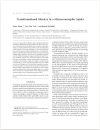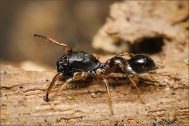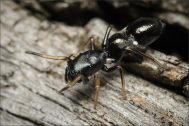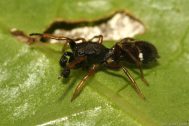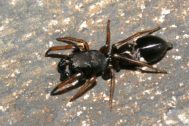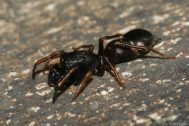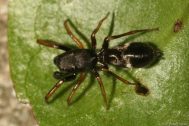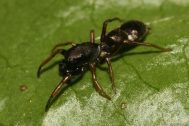| Nálezy podle období | |||||
|---|---|---|---|---|---|
| Salticidae | 0-1900 | 1901-1950 | 1951-2000 | 2001+ | ∑ |
| Leptorchestes berolinensis (C. L. Koch, 1846) Ohrožený | 1× | 1× | 6× | 31× | 39× |
Leptorchestes berolinensis (C. L. Koch, 1846)
| České jméno | skákavka mravencovitá |
|---|---|
| Stupeň ohrožení | Ohrožený |
| Nálezy | 39 nálezů, 15 kvadrátů |
| První nález |
1894, A. Nosek, Nosek 1895 |
| Poslední nález | 2022 , Filip Trnka |
| Areál rozšíření | Palaearctic - E-A |
| Fytogeografická oblast |
|
| Původnost stanovišť |
|
| Vlhkost stanovišť |
|
| Stratum |
|
| Osvětlení stanovišť |
|
| Hojnost výskytu |
|
| Nadm. výška | 150-500 |
Literatura
Pavouci NPR Bublák
Tato diplomová práce se zabývá araneofaunou Národní přírodní památky Bublák a niva Plesné. Byl proveden inventarizační průzkum pavouků tohoto území. Sběr jedinců proběhl pomocí zemních pastí, smykem a prosevem v termínu od 20. dubna do 15. října 2020. Celkem bylo zaznamenáno 110 druhů pavouků náležících do 19 čeledí. Mezi nejzajímavější zjištěné taxony řadíme nálezy: skákavka mravencovitá (Leptorchestes berolinensis), slíďák mokřinný (Pardosa paludicola), slíďák rašeliništní (Piratula uliginosa), plachetnatka rybniční (Bathyphantes setiger) a pavučenka dvoubarvá (Tmeticus affinis). Zjištěné výsledky přispějí k doplnění údajů do čtverců faunistického mapování živočichů a společně s entomologickými průzkumy přispějí k nastavení vhodného managementu lokality.Výsledky faunistického průzkumu pavouků a sekáčů na vybraných lokalitách na území NP Podyjí v roce 2019
A total of 114 spider species from 25 families and one harvestmen species were found during the zoological research at several sites in the Podyjí National Park during 2019. Of them, forty-one species are listed in the Red List of spiders of the Czech Republic. Four new species for the Podyjí NP were recorded – Callilepis nocturna (Linnaeus, 1758), Euryopis laeta (Westring, 1861), Phrurolithus minimus C. L. Koch, 1839 and Trichoncus auritus (L. Koch, 1869). Among the most interesting species, four critically endangered spiders – Civizelotes caucasius (L. Koch, 1866), Phrurolithus szilyi Herman, 1879, Gnaphosa modestior Kulczyński, 1897 and Eresus moravicus Řezáč, 2008 should be mentioned. Other rare species include Acartauchenius scurrilis (O. Pickard-Cambridge, 1873), Agyneta fuscipalpa (C. L. Koch, 1836), Arctosa figurata (Simon, 1876), Atypus affinis Eichwald, 1830, Bassaniodes robustus (Hahn, 1832), Callilepis schuszteri (Herman, 1879), Centromerus incilium (L. Koch, 1881), Centromerus leruthi Fage, 1933, Cheiracanthium effossum Herman, 1879, Drassyllus villicus (Thorell, 1875), Euryopis quinqueguttata Thorell, 1875, Frontinellina frutetorum (C. L. Koch, 1835), Gibbaranea gibbosa (Walckenaer, 1802), Gnaphosa opaca Herman, 1879, Haplodrassus cognatus (Westring, 1861), Haplodrassus dalmatensis (L. Koch, 1866), Haplodrassus minor (O. Pickard-Cambridge, 1879), Heterotheridion nigrovariegatum (Simon, 1873), Kishidaia conspicua (L. Koch, 1866), Leptorchestes berolinensis (C. L. Koch, 1846), Minicia marginella (Wider, 1834), Phrurolithus pullatus Kulczyński, 1897, Trichopterna cito (O. Pickard-Cambridge, 1873), Walckenaeria simplex Chyzer, 1894, Zelotes erebeus (Thorell, 1871) and Zora manicata Simon, 1878.Transformational mimicry in a myrmecomorphic spider.
Species that are Batesian mimics during postembryonic development shift between mimetic models as they grow in size. However, it has not yet been tested whether these successive mimetic phenotypes are similarly protected from predators. Early-instar phenotypes could represent an inaccurate phenotype or an accurate phenotype because of selection from different predators. Here, we tested the hypotheses of transformational Batesian mimicry in the ant-mimicking jumping spider Leptochestes berolinensis. We quantified the mimetic accuracy of different ontogenetic stages to potential ant models by using a multitrait approach. We measured movement, body profile, body size, and coloration. Analysis revealed adults to be more accurate mimics than juveniles. Adults were similar to smaller morphs of Camponotus or Lasius ants, whereas juveniles were more similar to Lasius and Colobopsis ants. We tested whether predators, mantises, and Pisaura spiders were deceived by mimics after having experience with ant models. These predators never captured any ant or a mimic but always captured the nonmyrmecomorphic spider. We conclude that Leptorchestes berolinensis is a Batesian mimic of ants undergoing transformational mimicry, with all stages being accurate mimics.Spiders and pseudoscorpions (Arachnida: Araneae, Pseudoscorpiones) in old oaks of Central European floodplains.
Spiders and pseudoscorpions on old pedunculate oaks (Quercus robur) with tree cavities were studied in a Central European floodplain (South Moravia, Czech Republic). Altogether 322 specimens from 47 spider taxa and 71 specimens of six pseudoscorpion species were collected during 2010 and 2011 from tree cavities using two methods. More specimens and species of spiders were obtained from flight interception traps and more specimens and species of pseudoscorpions were obtained from pitfall traps. Remarkable records represent typical cavity dwellers, i.e. the spider Midia midas (Simon, 1884), the pseudoscorpions Larca lata (Hansen, 1884) and Apocheiridium ferum (Simon, 1879), the latter occurs mostly under tree bark. Five arachnid species are listed in the Czech red list: Midia midas, Leptorchestes berolinensis (C. L. Koch, 1846), Dipoena erythropus (Simon, 1881), Larca lata and Dendrochernes cyrneus (L. Koch, 1873).
Spiders and pseudoscorpions (Arachnida: Araneae, Pseudoscorpiones) in old oaks of Central European floodplains.
Spiders and pseudoscorpions on old pedunculate oaks (Quercus robur) with tree cavities were studied in a Central European floodplain (South Moravia, Czech Republic). Altogether 322 specimens from 47 spider taxa and 71 specimens of six pseudoscorpion species were collected during 2010 and 2011 from tree cavities using two methods. More specimens and species of spiders were obtained from flight interception traps and more specimens and species of pseudoscorpions were obtained from pitfall traps. Remarkable records represent typical cavity dwellers, i.e. the spider Midia midas (Simon, 1884), the pseudoscorpions Larca lata (Hansen, 1884) and Apocheiridium ferum (Simon, 1879), the latter occurs mostly under tree bark. Five arachnid species are listed in the Czech red list: Midia midas, Leptorchestes berolinensis (C. L. Koch, 1846), Dipoena erythropus (Simon, 1881), Larca lata and Dendrochernes cyrneus (L. Koch, 1873).
Fotografie
Statistiky
Dle měsíce v roce
Dle nadmořské výšky
Dle metody sběru (39 použitých nálezů)
| Leptorchestes berolinensis (C. L. Koch, 1846) VU | Samci | Samice | Mláďata | Nálezy |
|---|---|---|---|---|
| Smyk | 1 | 0 | 0 | 1 |
| Zemní past | 4 | 2 | 11 | 9 |
| Neurčeno | 2 | 3 | 0 | 8 |
| Nárazová past | 3 | 1 | 0 | 4 |
| Individuální sběr | 21 | 19 | 0 | 14 |
| Fotografie | 1 | 0 | 0 | 1 |
| Pozorování | 0 | 0 | 0 | 1 |
| Sklepávání | 1 | 0 | 0 | 1 |
| Samci | Samice | Mláďata | Nálezy |
Dle biotopu (39 použitých nálezů)
| Leptorchestes berolinensis (C. L. Koch, 1846) VU | Samci | Samice | Mláďata | Nálezy |
|---|---|---|---|---|
| Vřesoviště nižších poloh | 1 | 0 | 0 | 1 |
| Neurčeno | 10 | 7 | 8 | 23 |
| Lužní lesy nížin | 4 | 0 | 0 | 4 |
| Interiéry budov | 0 | 1 | 0 | 1 |
| Suché louky | 10 | 10 | 0 | 1 |
| Suché doubravy | 4 | 4 | 0 | 3 |
| Písčiny | 0 | 1 | 0 | 1 |
| Mezofilní louky | 2 | 0 | 3 | 1 |
| Suťové a roklinové lesy | 0 | 1 | 0 | 1 |
| Paseky | 0 | 0 | 0 | 1 |
| Lesní okraje | 0 | 1 | 0 | 1 |
| Lesostepní doubravy | 2 | 0 | 0 | 1 |
| Samci | Samice | Mláďata | Nálezy |


